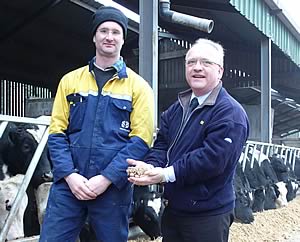| 07/04/08
With cereal prices remaining firm at around the £160/t
DM mark, an increasing number of traditional ad lib barley
beef finishing systems are finding that they are having
to make adaptations to their enterprise in order to remain
profitable. At around £57/t DM, forage maize is definitely
worth considering as a diet replacement according to one
Yorkshire finisher.
Doug Dear and NK's Nigel Padbury
 |
Swapping an intensive barley-based beef finishing system
for a total mixed ration featuring forage maize is enabling
Doug Dear to maintain a viable large scale finishing enterprise
at Osgodby Grange, Osgodby, Selby. “The time to finishing
our monthly turnover of 40 black and white bulls to 300kg
target deadweight has been reduced by an average of four
weeks to 14 months, and feed cost has been virtually halved
to 74p/kg liveweight gain,” he told more than 60 visitors
at a joint NK and Keenan open day he hosted.
“The blueprint diet is enabling the bulls to achieve
a DLWG of 1.4kg, with feed costs working out at £132/t
DM to leave an acceptable margin over all feeds of £157
a head,” he said. “In fact, such is the new feed
regime’s success that we plan to double the area of
maize grown this year to 100 acres and include NK Bull, the
highest yielding variety on the NIAB 2008 Forage Maize Descriptive
List.
“One of our objectives had been to add value to our
home-grown feed barley, and operating an intensive finishing
system was profitable when the market price stood at £60/t.
However, as the market firmed and headed towards £160/t,
our costs flew out of the window and we had to sit down to
consider the enterprise’s future,” explained
Doug who farms the 750 arable acre unit in partnership with
his parents, Alan and Elizabeth.
“We had gradually expanded the unit over the last 10
years to achieve an annual turnover of up to 600 finished
bulls and we were reluctant to see it fold. We had constructed
purpose built Dutch barn style accommodation, the system
fitted in with our unit’s workload, and it provided
a reliable monthly cash flow as well as added interest – we
enjoy rearing stock.”
To remain profitable and enable as much grain as possible
to be sold straight off the farm the Dears discussed introducing
a high fibre finishing diet with vastly reduced levels of
barley. They decided to purchased a Keenan Klassik 140 mixer
wagon in order to incorporate alternative feeds and straw,
and as part of the Keenan system they were offered nutritional
support from Rumans. “We were set the task of formulating
a simple system that would reduce feed costs, improve daily
liveweight gain and reduce the time the animals are on farm,” explained
Keenan Rumans consultant nutritionist, Seth Wareing. “We
also monitor animal and ration performance to ensure that
everything is going to plan. Within weeks, they found the
blueprint feeding strategy was going a long way to achieving
their goals.”
Doug, who each month buys in between 40
and 50, 12-weeks old black and white bulls to enter the unit’s
rolling programme added: “A mixed ration is easy to
feed out, the beasts like it and they appear more content.
This high fibre diet is more natural, and it’s helped
to virtually eliminate acidosis and other digestive upsets.” The
diet’s base comprises forage maize with stock feed
potatoes, fodder beet, protein, cereals and straw. Rolled
barley now makes up just one third of the diet’s DM
content and the Dears are currently considering replacing
it completely with a biscuit meal or similar alternatives.
Growing maize at Osgodby Grange was a natural progression
for the family and came at the expense of sugar beet, he
said. “Growing beet is no longer worthwhile, so three
years ago we introduced a trial 14 acres of maize into the
rotation and we clamped it on the sugar beet concrete pad.
We could see the benefits of adding forage maize to the bulls’ diet,
so we expanded the area to 45 acres, and this year we’ve
scheduled 100 acres in the cropping programme.”
Argrain’s Robin Rank explained: “The Dears are
going for a crop with high digestible yield, so they want
to harvest the maximum amount of energy from high volumes
of digestible dry matter. NK Bull is a suitable top quality
general purpose variety with the potential to make improvements
on last year’s crop productivity.” At 111% of
control, NK Bull has the highest available DM yield and the
best score for digestibility at 11.5MJ/kg DM on the NIAB
Descriptive List. It delivers an unbeaten 216,000MJ/ha and
a very high starch content of 32.8%, the highest in its class.
In addition, NK Bull also has a high vigour rating of 8.5
together with the list’s top rating for standing power.
Doug Dear added: “We’ve found that forage maize
is a very good break crop in the arable rotation – it’s
a perfect entry to winter wheats. We sow with a modified
arable drill. Also we approach maize as an arable crop; it
doesn’t like competition so we treat accordingly with
pre and post-emergence broadleaved and grass herbicides.
In future, we would like to grow more forage maize in order
to include maize in the diet all year long. We would welcome
the opportunity to rent a further 100 acres within an arable
system.”
 Red Mites Potential Source of Salmonella Transmission Red Mites Potential Source of Salmonella Transmission
 New Feeds Developed to 'Max' on Grass But Not on Cost New Feeds Developed to 'Max' on Grass But Not on Cost
 Rearing Surplus Lambs to Improve Flock Margins Rearing Surplus Lambs to Improve Flock Margins |



